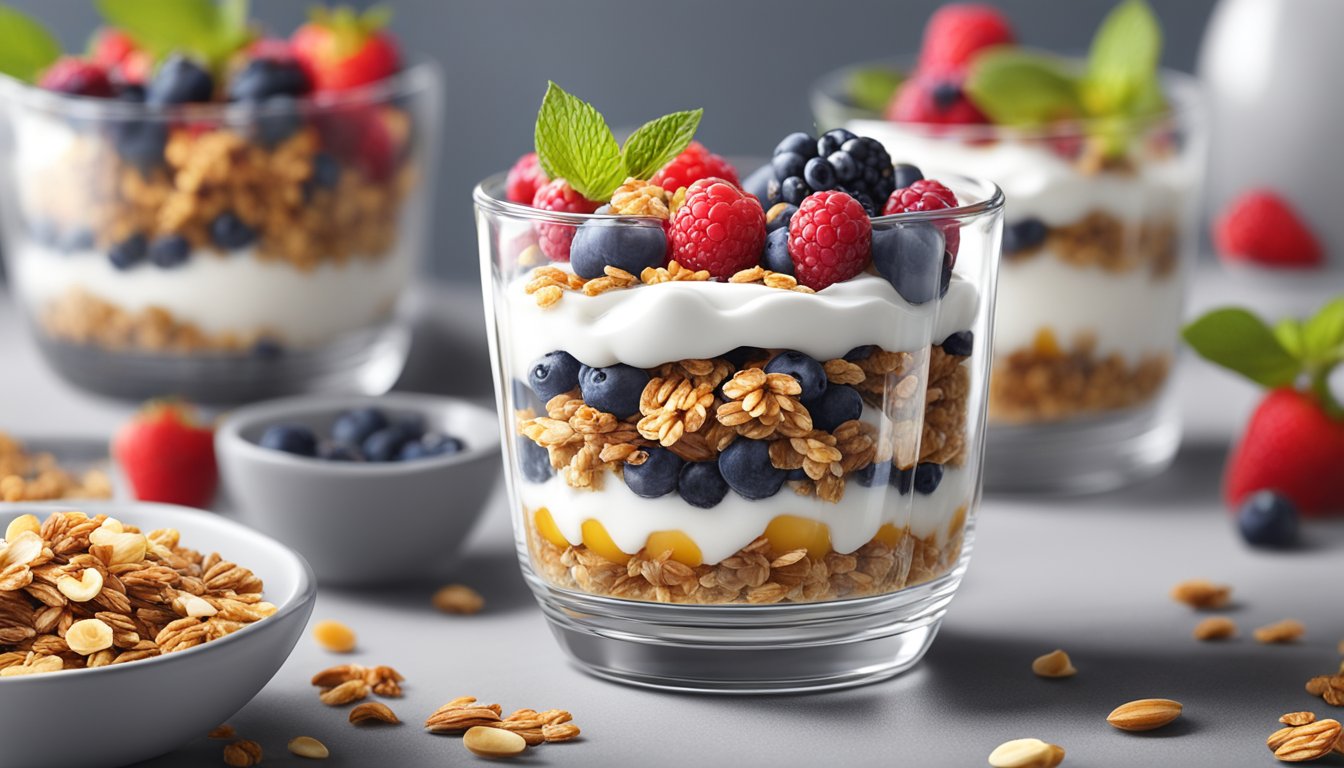The Greek yogurt parfait has become a beloved breakfast and dessert option, combining creamy yogurt with layers of fruit, granola, and other toppings. This modern interpretation evolved from the traditional French parfait, which originated in the 1890s as a frozen dessert. Greek yogurt parfaits gained popularity in the United States during the early 20th century, offering a healthier alternative to their ice cream-based predecessors.
The word “parfait” means “perfect” in French, aptly describing the harmonious blend of flavors and textures in this layered treat. Greek yogurt adds a rich, tangy element to parfaits, providing a protein-packed base that complements the sweetness of fresh fruits and the crunch of nuts or granola. Its thick consistency makes it ideal for creating distinct layers, resulting in an visually appealing and delicious dish.
History and Origin
The parfait’s journey from French culinary tradition to modern-day Greek yogurt creation spans over a century of culinary innovation. Its evolution reflects changing tastes and cultural influences across continents.
The French Roots
The parfait originated in France in the 1890s as a frozen dessert. French chefs crafted it by boiling cream, eggs, sugar, and syrup to create a custard-like mixture. This concoction was then frozen, resulting in a smooth, rich dessert. The name “parfait” means “perfect” in French, aptly describing its luxurious texture and taste.
Early parfaits were often flavored with coffee or chocolate. Chefs served them in tall, narrow glasses to showcase the dessert’s elegant appearance. The French parfait quickly gained popularity among the upper classes as a sophisticated after-dinner treat.
Adoption in America
American chefs embraced the parfait concept in the early 20th century, adapting it to suit local tastes. Unlike its frozen French counterpart, the American parfait evolved into a layered dessert. Culinary professionals and home cooks alike began creating parfaits with ice cream, fruit, and whipped cream.
The versatility of the American parfait led to its widespread popularity. Restaurants started offering parfaits as both desserts and breakfast items. The layered presentation in tall glasses became a signature feature, allowing diners to see the colorful ingredients.
Evolution of the Greek Yogurt Parfait
The Greek yogurt parfait emerged as a healthier alternative to traditional dessert parfaits. This evolution coincided with the rising popularity of Greek yogurt in the United States during the early 2000s. Greek yogurt’s thick, creamy texture and high protein content made it an ideal base for a nutritious parfait.
Typical ingredients in a Greek yogurt parfait include:
- Greek yogurt
- Fresh fruits (berries, peaches, or tropical fruits)
- Granola or nuts for crunch
- Honey or maple syrup as a sweetener
Health-conscious consumers embraced this version for its balance of taste and nutrition. The Greek yogurt parfait quickly became a staple in cafes, restaurants, and home kitchens as a breakfast option or light dessert.
Greek Yogurt Explained
Greek yogurt stands out for its thick texture and protein-rich profile. It offers a versatile option for parfaits and other culinary applications.
Nutritional Profile
Greek yogurt packs a powerful nutritional punch. It contains high levels of protein, typically twice as much as regular yogurt. A 6-ounce serving provides about 15-20 grams of protein, supporting muscle growth and repair.
Greek yogurt is also rich in calcium, promoting bone health. It contains probiotics, beneficial bacteria that support gut health and boost immunity. The fermentation process reduces lactose content, making it easier to digest for some people with lactose sensitivities.
This yogurt variety is lower in carbohydrates and sugar compared to traditional yogurt. It offers a good source of B vitamins, particularly B12, which is essential for red blood cell formation and neurological function.
Comparison with Traditional Yogurt
Greek yogurt differs from traditional yogurt in texture and composition. The straining process removes much of the liquid whey, lactose, and sugar, resulting in a thicker, creamier consistency.
This straining concentrates the protein content, making Greek yogurt a more filling option. It has a tangier taste compared to regular yogurt due to its higher concentration of lactic acid.
Traditional yogurt tends to be smoother and runnier. It contains more calcium and less sodium than Greek yogurt. However, Greek yogurt often has less sugar and fewer carbohydrates, making it a popular choice for low-carb diets.
Greek yogurt’s thicker texture makes it ideal for parfaits, as it holds up well when layered with fruits and granola. Its versatility extends to both sweet and savory applications in cooking and baking.
Essential Components of a Parfait
A parfait combines layers of creamy, crunchy, and fruity elements to create a delightful harmony of flavors and textures. The key ingredients work together to provide a balanced and satisfying eating experience.
Primary Layers
Yogurt forms the foundation of most parfaits. Greek yogurt is a popular choice due to its thick, creamy texture and high protein content. Plain yogurt offers versatility, while flavored varieties add extra sweetness. Granola provides a crunchy contrast to the smooth yogurt. It typically consists of rolled oats, nuts, and sweeteners baked until crispy. The granola layer adds fiber and a satisfying crunch.
Fresh fruit brings natural sweetness and vibrant colors to parfaits. Common choices include berries, sliced bananas, and diced peaches. Fruits contribute essential vitamins and antioxidants, making parfaits a nutritious option for breakfast or snacks.
Popular Add-ins
Nuts enhance parfaits with extra crunch and healthy fats. Walnuts, almonds, and pecans are frequently used. They can be whole, chopped, or slivered. Honey is a natural sweetener that complements the tanginess of yogurt. It adds a golden touch and helps bind the ingredients together.
Seeds like chia or flax boost the nutritional value with omega-3 fatty acids. Dried fruits such as raisins or cranberries provide chewy texture and concentrated sweetness. Some parfaits incorporate a layer of fruit preserves or compote for intense flavor.
Creative Toppings
A drizzle of maple syrup or agave nectar can replace honey as a sweetener. Chocolate lovers might enjoy a sprinkle of cocoa nibs or dark chocolate chips. Coconut flakes add tropical flair and extra texture.
For a dessert-like twist, whipped cream can be layered in or used as a finishing touch. A dusting of cinnamon or nutmeg enhances the flavor profile. Some creative parfaits feature unexpected toppings like crushed cookies, cereal, or even savory elements like pumpkin seeds or herbs.
Variations and Recipes
Greek yogurt parfaits offer endless possibilities for customization. From classic combinations to creative dessert options, these layered treats can be adapted to suit different tastes and occasions.
Classic Parfait Recipes
The traditional Greek yogurt parfait combines creamy yogurt with fresh fruits and crunchy granola. A popular version layers vanilla Greek yogurt with mixed berries and honey-drizzled granola. Another classic recipe features sliced bananas, chopped walnuts, and a sprinkle of cinnamon. For a tropical twist, try mango chunks with coconut flakes and macadamia nuts. These parfaits work well as breakfast or snacks, providing a balance of protein, fiber, and natural sweetness.
Greek Yogurt Variations
Greek yogurt’s versatility allows for diverse flavor combinations. A savory parfait might include cucumber, dill, and crumbled feta cheese. For a protein-packed option, blend Greek yogurt with peanut butter and top with sliced apples and a drizzle of honey. A Mediterranean-inspired parfait could feature Greek yogurt mixed with olive oil and za’atar, layered with roasted vegetables and pine nuts. These variations showcase Greek yogurt’s adaptability in both sweet and savory applications.
Dessert Parfaits
Greek yogurt parfaits can transform into indulgent desserts without sacrificing nutritional value. A chocolate lover’s parfait layers chocolate Greek yogurt with crushed chocolate cookies and fresh raspberries. For a cheesecake-inspired treat, mix Greek yogurt with cream cheese and vanilla, then layer with graham cracker crumbs and a berry compote. A frozen yogurt parfait combines Greek yogurt with honey and favorite mix-ins, then freezes the layers for a refreshing dessert. These dessert parfaits offer a healthier alternative to traditional sweets while still satisfying cravings.
Serving and Presentation
Greek yogurt parfaits offer endless possibilities for creative presentation. The visual appeal of layered ingredients in a clear glass creates an enticing dessert that’s as beautiful as it is delicious.
The Art of Layering
Layering is key to creating an impressive parfait. Start with a base of Greek yogurt, followed by a fruit layer. Repeat these layers, alternating colors and textures for visual interest. Use a spoon to carefully place each layer, avoiding smears on the glass sides. For a striking effect, tilt the glass while layering to create diagonal stripes. Experiment with different layer thicknesses to find the perfect balance.
Consider adding a fruit purée layer for extra flavor and color. Raspberry or mango purées work well, providing vibrant hues and complementary tastes. Include a crunchy element like granola or crumbled cookies between layers for added texture.
Choosing the Right Glass
The right vessel enhances the parfait’s presentation. Tall glasses are ideal, allowing ample space for multiple layers. Clear glasses showcase the colorful layers and intricate design. Stemmed parfait glasses add elegance, while mason jars offer a rustic charm.
Consider the parfait’s size when selecting a glass. Individual servings work well in 8-12 oz glasses, while larger parfaits for sharing can be served in trifle bowls. Wide-mouthed glasses make it easier to add layers and enjoy the parfait.
Garnishing Techniques
Garnishes add the finishing touch to a parfait. Fresh fruit on top provides color and indicates the flavors within. Whole berries, sliced strawberries, or kiwi fans are popular choices. A sprinkle of granola or crushed nuts adds texture and visual appeal.
For an indulgent touch, drizzle honey or chocolate sauce over the top. Mint leaves offer a pop of green and a fresh aroma. Edible flowers like pansies or violets create an elegant look for special occasions.
Consider a dusting of cocoa powder or cinnamon for warm, earthy tones. A dollop of whipped cream can add height and luxury to the presentation.
Health and Nutrition
Greek yogurt parfaits offer a balance of indulgence and nutrition. They provide protein, probiotics, and calcium while allowing for customization to suit various dietary needs.
Balancing Indulgence and Nutrition
Greek yogurt parfaits can be a nutritious treat when prepared thoughtfully. The protein-rich Greek yogurt forms a solid foundation, supporting muscle repair and growth. It’s an excellent source of calcium, promoting bone health. Parfaits often include fresh fruits, adding essential vitamins, minerals, and fiber to the mix.
Granola or nuts contribute healthy fats and additional fiber. However, these toppings can also increase calorie content. To maintain a healthier profile, opt for unsweetened granola or measure portions of nuts carefully.
Sugar content is a key consideration. Plain Greek yogurt has minimal added sugars. Fruits provide natural sweetness, but some parfait recipes call for honey or syrup. Moderation is crucial when adding these sweeteners to keep the parfait a balanced choice.
Dietary Considerations
Greek yogurt parfaits can accommodate various dietary needs. For those watching their carbohydrate intake, using berries instead of higher-sugar fruits can help. Low-fat or non-fat Greek yogurt options are available for individuals monitoring fat consumption.
Parfaits are naturally gluten-free if made without granola. For a gluten-free version, substitute with nuts or seeds. Lactose-intolerant individuals might opt for lactose-free Greek yogurt varieties.
Vegan alternatives exist, using plant-based yogurts made from soy, coconut, or almond. These options may have different nutritional profiles compared to dairy-based Greek yogurt.
For weight management, portion control is key. A parfait can be a satisfying meal or snack when appropriately sized. It’s important to be mindful of added sugars and high-calorie toppings to maintain the parfait’s status as a healthy dessert option.
Cultural Significance and Trends

Greek yogurt parfait has become a cultural icon, blending traditional Greek ingredients with modern culinary trends. Its popularity extends beyond Greece, influencing global food culture and health-conscious eating habits.
Parfait in Modern Cuisine
Greek yogurt parfait has emerged as a versatile and trendy dish in modern cuisine. It’s popular as a breakfast item, dessert, and snack. The layered presentation of Greek yogurt, fruits, nuts, and honey creates an visually appealing and Instagram-worthy dish.
Savory yogurt parfaits have also gained traction, featuring ingredients like:
- Roasted vegetables
- Herbs
- Olive oil
- Sea salt
This trend showcases the adaptability of Greek yogurt in both sweet and savory applications.
Annual Celebrations
National Parfait Day, celebrated on November 25, highlights the cultural significance of this layered treat. The day encourages people to create their own parfait variations and share them on social media.
Many cafes and restaurants offer special parfait promotions during this time. Some popular parfait-related activities include:
- Parfait-making contests
- Greek yogurt parfait cooking classes
- Themed parfait brunches
These celebrations contribute to the ongoing popularity of Greek yogurt parfaits and their place in contemporary food culture.
Future of the Parfait
The parfait continues to evolve, with new innovations and expanding market potential. Greek yogurt parfaits in particular have seen significant growth in popularity and sales.
Innovations in Parfait Making
Parfait makers are experimenting with unique flavor combinations and ingredient pairings. Some incorporate savory elements like herbs or spices into traditionally sweet parfaits. Others focus on using locally-sourced, organic ingredients.
Plant-based parfaits are gaining traction, catering to vegan and dairy-free consumers. These often use coconut, almond, or oat-based yogurt alternatives.
Parfait bars, where customers can customize their parfait layers, are becoming popular in cafes and restaurants. This interactive approach appeals to those seeking personalized experiences.
Potential Market Growth
The Greek yogurt market in the U.S. has seen substantial growth, increasing from $3.2 billion in 2010 to over $8.8 billion in 2020. This trend suggests continued potential for parfait market expansion.
Fast-food chains and coffee shops are likely to introduce more parfait options to meet consumer demand for healthier choices. Starbucks has already capitalized on this trend with their Greek yogurt parfaits.
Parfait delivery services and pre-packaged parfait kits for home assembly present new market opportunities. These cater to busy consumers seeking convenient, healthy options.
Seasonal and limited-time parfait offerings may become more common, driving sales through novelty and exclusivity.




